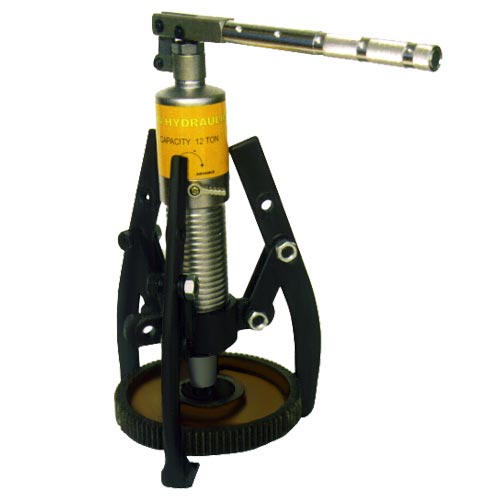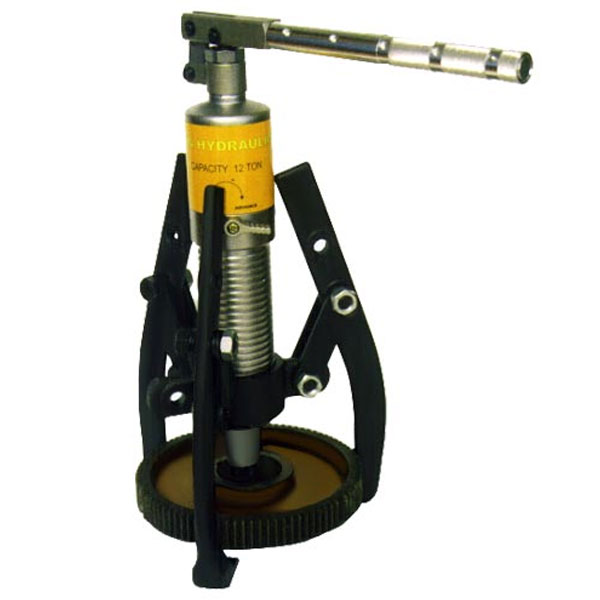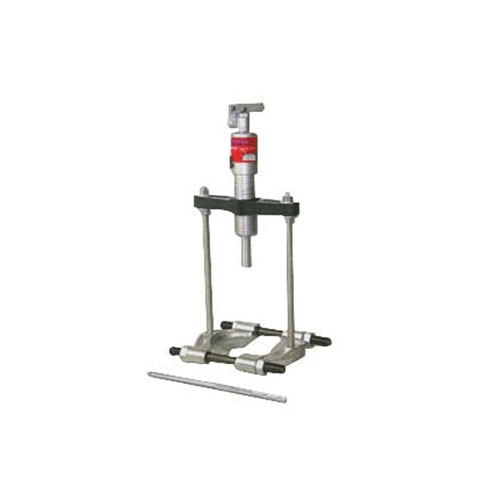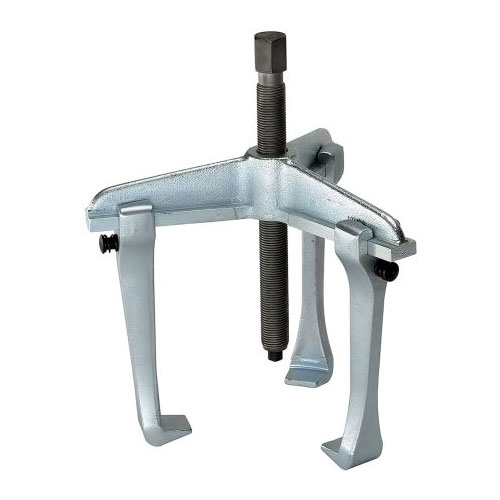Hydraulic Puller
What is a Hydraulic Puller?
A hydraulic puller is a tool that is used for safe and easy removal in a variety of applications. It features a strong grip behind the bearing’s inner ring, which ensures that the pulling forces are only transmitted through the inner ring, preventing any damage to the outer ring or the moving parts. Hydraulic pullers offer a simple solution for removing shaft-mounted items such as bearings, gears, sleeves, wheels, sprockets, and eliminate tedious and hazardous pounding, heating or prying. They are made from high-quality materials, appreciated for their robust construction, high strength, excellent finish, and dimensional accuracy. Furthermore, hydraulic pullers are available in different specifications to meet the exact requirements of customers. They are widely used for removing gears, bearings, and other press-fitted parts with ease.
GM Industries is one of the leading hydraulic puller manufacturers that specializes in manufacturing high-quality hydraulic pullers. They offer a wide range of hydraulic pullers that are designed to meet the diverse needs of their customers. GM Industries’ hydraulic pullers are made from premium materials and are engineered to provide maximum strength and durability. With their extensive knowledge and expertise in the field, GM Industries has become a trusted name in the industry as one of the most prominent hydraulic puller suppliers and is committed to providing their customers with the best products and services.
Types of Pullers
GM Industries is a company that specializes in manufacturing high-quality hydraulic pullers. The hydraulic pullers consist of a self-contained hydraulic pump and puller body with integral safety valve. GM hydraulic pullers are heat treated with forged alloy steel cross bolts and jaws with manganese phosphate plated.
This type of hydraulic puller comes with a separate hand pump, which allows for easier operation and greater control. The hand pump is used to generate hydraulic pressure, which is then used to pull the desired component.
This type of hydraulic puller comes with an inbuilt pump and separator. The pump generates hydraulic pressure, while the separator is used to remove the bearing or other component from the shaft.
This type of hydraulic puller comes with an inbuilt pump and separator. The pump generates hydraulic pressure, while the separator is used to remove the bearing or other component from the shaft.
Manual bearing pullers are used to remove bearings or other components from a shaft manually. They are typically operated using a sliding hammer, which is used to apply force to the component being removed.
CTRB jack type pullers are used to remove large bearings or other components from a shaft. They feature a hydraulic jack that generates a high amount of force, which is used to pull the component from the shaft.
Jaw type pullers are used to remove components that are press-fitted onto a shaft. They feature jaws that grip onto the component being removed, and a threaded rod that is used to apply force and pull the component off the shaft. 2 jaw pullers are typically used for smaller components, while 4 jaw pullers are used for larger components.
Hydraulic Puller Price
| Product Range | Price |
| GM Hydraulic Puller | – |
| Hydraulic Puller with Separate Hand Pump | ₹ 5.80 Lakh / Unit |
| Hydraulic Puller with Inbuilt Pump & Separator | ₹ 2 Lakh / Unit |
| Hydraulic Puller with Inbuilt Pump | – |
| Manual Bearing Pullers | ₹ 18,000 / Unit |
| CTRB Jack Type Puller | ₹ 2 Lakh / Unit |
| Jaw Type 2 /4 jaw Puller | ₹ 1.6 Lakh / Unit |
For more information on any of our high quality products or getting accurate prices contact GM Industries at
Call Us
+(91)-9820533489 / 7738562224
Enquiry Form
Submit
Hydraulic Puller Working Principle
The working principle of a hydraulic puller involves using hydraulic pressure to apply force and remove a component from a shaft.
The hydraulic puller typically consists of a hydraulic cylinder, a piston, a pulling head, and a hydraulic pump. The pulling head is attached to the component being removed, and the hydraulic cylinder is attached to the shaft.
When the hydraulic pump is activated, it generates hydraulic pressure, which is transmitted to the hydraulic cylinder. This pressure causes the piston to move, which in turn applies force to the pulling head. The pulling head grips onto the component being removed, and the force generated by the hydraulic pressure pulls the component off the shaft.
The hydraulic puller is designed to ensure that the pulling force is only transmitted through the inner ring of the bearing, preventing any damage to the outer ring or the moving parts. Hydraulic pullers offer a safe, efficient, and easy method for removing components from a shaft, without the need for pounding, heating, or prying.
Advantages of Hydraulic Puller
Hydraulic pullers offer several advantages over traditional methods of removing components from a shaft. Some of the key advantages of hydraulic pullers include:
Safe and easy operation
Hydraulic pullers are designed to provide a safe and easy method for removing components from a shaft, without the need for pounding, heating, or prying.
Precise Control
Hydraulic pullers offer precise control over the pulling force, allowing for more accurate and efficient removal of components
Reduced setup time
Hydraulic pullers with inbuilt pumps require less setup time compared to manual methods, making them a more efficient option.
Increased efficiency
Hydraulic pullers can generate a high amount of force, allowing for quicker and more efficient removal of components.
Versatility
Hydraulic pullers are available in a variety of sizes and specifications, making them suitable for a wide range of applications.
Reduced risk of damage
Hydraulic pullers are designed to ensure that the pulling force is only transmitted through the inner ring of the bearing, preventing any damage to the outer ring or the moving parts.
Overall, hydraulic pullers offer a safe, efficient, and easy method for removing components from a shaft, making them a popular choice in a variety of industries.
Applications of Hydraulic pullers
Hydraulic pullers find a variety of applications across different industries. Here are some examples of industrial applications of hydraulic pullers:
- Automotive industry: Hydraulic pullers are commonly used in the automotive industry for removing gears, pulleys, bearings, and other components from vehicles. They are also used in maintenance and repair tasks, such as disassembling engines and replacing parts.
- Manufacturing industry: Hydraulic pullers are used in the manufacturing industry for removing press-fitted components from machinery, such as wheels, sprockets, and sleeves. They are also used in the disassembly of large equipment and machinery.
- Mining industry: Hydraulic pullers with high pulling force capabilities are used in the mining industry for removing heavy components from mining equipment, such as gears, pulleys, and bearings.
- Marine industry: Hydraulic pullers are used in the marine industry for removing propellers, shafts, and other components from boats and ships.
- Construction industry: Hydraulic pullers are used in the construction industry for removing components from heavy machinery, such as excavators, bulldozers, and cranes.
- Aerospace industry: Hydraulic pullers are used in the aerospace industry for disassembling aircraft engines and other components.
Overall, hydraulic pullers are a versatile tool that finds applications in many different industries for various tasks such as maintenance, repair, and disassembly of equipment and machinery.

How do I choose a Hydraulic puller?
Selecting the appropriate hydraulic puller for your requirements can be a daunting task, but with the assistance of GM Industries, it doesn’t have to be. GM Industries is a well-known name in the hydraulic tools industry, providing high-quality and reliable hydraulic pullers for a variety of applications. With a wide range of products to choose from, customers can find the perfect hydraulic puller to suit their specific needs and requirements. The company’s focus on quality and customer satisfaction ensures that customers receive the best products and services possible. GM Industries’ expertise and experience in the industry make it an ideal partner for finding the right hydraulic puller for any application. Customers can trust GM Industries to provide them with the right hydraulic puller for their needs, helping them to achieve their goals safely, efficiently, and effectively.
Frequently Asked Questions
A hydraulic puller is a tool that is used to remove press-fitted components from machinery, such as gears, pulleys, and bearings.
A hydraulic puller works by using hydraulic pressure to exert force on a component, pulling it away from the shaft it is attached to.
Different types of hydraulic pullers include those with separate hand pumps, those with inbuilt pumps and separators, and those with inbuilt pumps only.
The maximum pulling force of a hydraulic puller can vary depending on the specific model, but can range from a few tons to several hundred tons.
Components such as gears, pulleys, bearings, wheels, sprockets, and sleeves can be removed with a hydraulic puller.
Hydraulic pullers are commonly used in industries such as automotive, manufacturing, mining, marine, construction, and aerospace.
Factors to consider include the type and size of the component being removed, the pulling force required, and the available space for the tool.
Yes, hydraulic pullers are safe to use when used correctly and following proper safety procedures.
Maintenance of a hydraulic puller typically involves keeping it clean, checking for leaks, and ensuring that all components are properly lubricated.
Yes, hydraulic pullers with compact designs are available for use in tight spaces.
Hydraulic pullers can leak hydraulic fluid, which can be harmful to the environment if not properly contained and disposed of.
Yes, hydraulic pullers can be used to disassemble machinery for maintenance and repair purposes.
The size of the hydraulic puller needed will depend on the size of the component being removed and the pulling force required.
A manual bearing puller relies on manual force to remove components, while a hydraulic puller uses hydraulic pressure to exert force on the component.
Using a hydraulic puller with an inbuilt pump can save time and effort in the setup and use of the tool.
Hydraulic pullers designed for underwater use are available for marine applications.
Hydraulic pullers can be transported using a carrying case or storage box designed for the specific model.
No, hydraulic pullers are not designed for removing welded components.
Yes, hydraulic pullers can be used for both horizontal and vertical applications, depending on the specific model and design.







